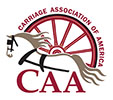
Studebaker Bros. Mfg. Co.
South Bend, Indiana
Ccirca 1900
Type:
A “sociable” is an alternative name for a carriage of this type, which has two facing seats placed across the carriage for passengers. It is an open carriage that first appeared in England in the 18th century. Some were made with a folding half-top, and in the second half of the 19th century, the folding canopy or umbrella top was produced and began to be used on the vis-à-vis and other carriages in America.
Provenance:
This carriage formerly belonged to the Lord Mayor of Hamilton, Bermuda, and was one of several that were sent to New York for sale for the benefit of New York charities, as referred to in the description of the game cart trap. This vehicle has been used on several occasions to transport dignitaries, most recently the King and Queen of Sweden on their visit to Bridgeton, New Jersey.
Builder:
The Studebaker Brothers Manufacturing Company was started about 1850 in South Bend, Indiana, by Clement Studebaker, one of five sons of John Studebaker, a blacksmith and wheelwright in Ashland, Ohio. Eventually, all five brothers formed a partnership as builders of farm vehicles and small carriages. In 1868 the firm was said to have produced 3,955 wagons. The firm exhibited at the Centennial Exposition in 1876, and at the World Columbian Exposition in Chicago in 1893, Studebaker had a large exhibit of carriages. They opened branches in many American cities and appointed selling agents in several countries overseas. They ceased making horse-drawn vehicles in 1919, and became automobile builders until the company was closed down in the 1980s.
